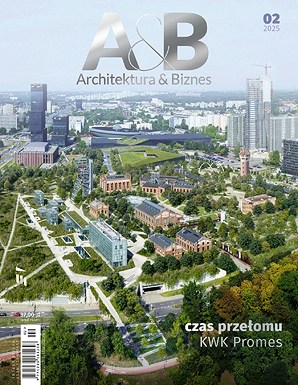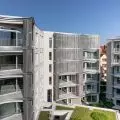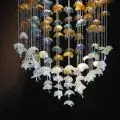Maria Milanowska from the Faculty of Architecture at Poznań University of Technology has won second place in the prestigious international Archiol Competitions. Her project "Arise Anew," completed as part of her master's thesis under the supervision of Dr. Ewa Angoneze-Greli, was recognized among participants and entrants from around the world.
scheme
© Maria Malinowska
competition
Archiol Competitions is an established platform that organizes international architectural competitions, attracting young designers from all over the world. This year 's edition , "Sensory Museum Design Competition 2024," focused on creating museum spaces designed to evoke emotions and engage all the senses. Participants were tasked with breaking the traditional approach to museum architecture by designing spaces, interacting with the human psyche and evoking deep emotional experiences.
The competition recognized many young architects and young architects. First place was won by a team consisting of Bruno Krehula, Mehdi Karimabad Nejati, Kiana Zarrabi and Noemi Sebban from Italy, while third place went to Luo Tian Yang from China.Honorable mentions were awarded to three representatives of Poland: Zofia Zielińska, Kacper Klaus and Barbara Pater.
The competition provided a unique opportunity to exchange ideas and look at architecture as a tool to shape human emotions.
board
© Maria Malinowska
Arise Anew project - new life for Ciechocinek
The "Arise Anew" project is a concept for a sensory museum that would be built in Ciechocinek, a spa town located in the Kujawsko-Pomorskie Voivodeship. Ciechocinek was chosen as the project's location not by accident - its tradition as a health resort, offering visitors a multi-sensory experience, fits perfectly with the competition's theme of sensory stimulation. The city has for years enjoyed a reputation as a place where contact with nature, architecture and rich cultural life promotes regeneration of body and mind.
The architecture of Ciechocinek is a fascinating mosaic of styles - from Zakopane, Swiss and classicist, to neo-Gothic and modernist. However, over the years, some of the buildings have fallen into neglect, and the city itself is struggling to cope with an exodus of young people. In response to these challenges, the "Arise Anew" sensory museum could breathe new life into the city.
The museum would aim not only to house exhibits, but also to create a space with which visitors could interact, engaging all of their senses. Such an innovative institution could attract both older and younger generations to Ciechocinek, making the city an attractive place to visit and an inspiring space to live and explore.
board
© Maria Malinowska
Pine Tree Park
Pine Park, where the sensory museum is planned to be located, is one of the three most important recreational places in Ciechocinek. Its history dates back to the late 19th century, and over the years the park's boundaries have expanded, becoming a popular place for nature walks. Still, not all visitors to the city center reach this more remote, eastern area of Ciechocinek.
Pine Tree Park can be divided into two parts - western and eastern.The western part has a valuable historical path system designed by Franciszek Szanior, which requires special protection and preservation. The eastern part of the park, however, does not match it aesthetically and compositionally. For this reason, the sensory museum project has been placed in this part, and the plans also include a new layout of walking paths, aimed at unifying the entire park area and restoring its coherence and former elegance.
The qualities of Pine Tree Park, such as the presence of numerous trees, squirrel trees and historic buildings, including the President's Mansion and the Pressure Tower, make it an ideal place to create a space that attracts both residents and tourists. The goal of the project is to revitalize the area and allow visitors to experience nature in a way that evokes the early stages of human sensory development, fostering reflection and regeneration.
visualization
© Maria Malinowska
underground museum
In order not to disturb the historic character of Pine Park and to respect the surrounding landscape, the sensory museum building was designed to be underground. The entrances are accessed by gently sloping ramps that connect to the park's walking paths. The design includes an ecological and economical solution of using soil from the excavation of the building for the wall structure. Construction with rammed earth has a long tradition of vernacular architecture in Poland. To ensure the durability and safety of the structure in underground conditions, the building was based on a monolithic reinforced concrete structure, with rammed earth walls acting as partitions.
The interior of the museum reflects the process of human sensory development. The tour begins in a darkened, muted room, reminiscent of prenatal conditions. The visitor then walks through a corridor lined with fine fabrics, leading to a balance experimentation zone - with platforms, balance boards and hammocks. Another part of the exhibit provides a temperature experience, offering a variety of sensations of heat, cold and humidity, as well as a tactile zone where one can feel the weight of the body thanks to pillows and a prickly structure.
The museum also has a light zone, where an intense stream enters through skylights, creating a contrast of light and shadow. The sound zone is equipped with tubes carrying a variety of sounds, immersing visitors in a wealth of sensory experiences. In the gastronomic area, visitors can bake bread with their own hands, and in the olfactory zone they can create their own unique fragrance.
visualization
© Maria Malinowska
The highlight of the exhibition is the outdoor area, where visitors can look up at the treetops, experiencing the fullness of nature with all their senses. The design also provides space for temporary exhibitions and workshops, allowing the museum to remain relevant regardless of changing cultural trends. All elements of the museum, including ramps and exhibits, have been designed with accessibility in mind for people of all ages, including those with disabilities, making the museum a space open to all.
Aleksandra Skorupa


































